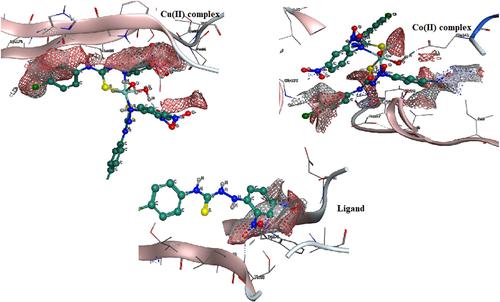当前位置:
X-MOL 学术
›
Appl. Organomet. Chem.
›
论文详情
Our official English website, www.x-mol.net, welcomes your
feedback! (Note: you will need to create a separate account there.)
Electrochemical synthesis for new thiosemicarbazide complexes, spectroscopy, cyclic voltammetry, structural properties, and in silico study
Applied Organometallic Chemistry ( IF 3.7 ) Pub Date : 2020-10-18 , DOI: 10.1002/aoc.6049 Moamen Refat 1, 2 , Nashwa El‐Metwaly 3, 4 , Yamany B. Yamany 5 , Ismail Althagafi 3 , Ahmed Hameed 3 , Arwa Alharbi 3 , Matokah Abualnaja 3 , Reem Shah 3 , Ashraf Al‐Brakati 6 , Jehan Y. Al‐Humaidi 7
Applied Organometallic Chemistry ( IF 3.7 ) Pub Date : 2020-10-18 , DOI: 10.1002/aoc.6049 Moamen Refat 1, 2 , Nashwa El‐Metwaly 3, 4 , Yamany B. Yamany 5 , Ismail Althagafi 3 , Ahmed Hameed 3 , Arwa Alharbi 3 , Matokah Abualnaja 3 , Reem Shah 3 , Ashraf Al‐Brakati 6 , Jehan Y. Al‐Humaidi 7
Affiliation

|
A new thiosemicarbazide derivative ligand (HDCTS) was prepared from the reaction between 2,4‐dinitrophenylhydrazine and 4‐chlorophenyl isothiocyanate. Co(II) and Cu(II) complexes were synthesized from HDCTS derivative by electrochemical method to reach preferable yield in a safe environment. The new complexes as well as the original ligand were fully characterized to establish their chemical formulae. The spectral (infrared, Raman, mass, and ultraviolet–visible), analytical (elemental, thermogravimetric analysis [TGA], and cyclic voltammetry), and conformational techniques were implemented for characterization. According to spectral data and magnetic moments, the octahedral arrangement was proposed around metals through mono‐negative bidentate mode of bonding. TGA discriminates and quantitatively evaluates the presence of water molecules within two complexes. Electrochemical study was interested for all new compounds and suggests the electrode couples to be close for quasi‐reversible behavior. Elaborated conformational study was displayed to extract significant characteristics, which assert firstly on the mode of bonding inside the complexes. The perfect distribution of NH and CS groups inside the optimized structures facilitates their coordination as spectrally proposed. Crystal explorer program was used to investigate the degree of contact between molecules inside crystal packing systems. Effective contribution in surface contact feature was noticed from O and Cl atoms. A certified in silico study concerning the docking feature of new compounds against effective proteins in allergy and inflammation diseases was done. According to data exported, a promising anti‐allergic or anti‐inflammatory efficiency is expected strongly from Cu(II)–DCTS complex.
中文翻译:

新型硫代氨基脲配合物的电化学合成,光谱法,循环伏安法,结构性质和计算机模拟研究
通过2,4-二硝基苯基肼与4-氯苯基异硫氰酸酯之间的反应制备了新的硫代氨基脲衍生物配体(HDCTS)。由HDCTS衍生物通过电化学方法合成Co(II)和Cu(II)配合物,以在安全的环境中达到理想的收率。对新的配合物以及原始的配体进行了充分表征,以建立其化学式。光谱(红外,拉曼,质量和紫外可见),分析(元素,热重分析[TGA]和循环伏安法)和构象技术均用于表征。根据光谱数据和磁矩,通过单负双齿键合模式在金属周围提出了八面体排列。TGA区分并定量评估两种复合物中水分子的存在。电化学研究对所有新化合物都感兴趣,并建议电极对应接近准可逆行为。精细的构象研究显示出提取的重要特征,这首先证明了复合物内部的键合方式。NH和CS基团在优化结构内的完美分布有助于光谱上的协调。使用Crystal Explorer程序研究晶体堆积系统内部分子之间的接触程度。从O和Cl原子注意到表面接触特征的有效贡献。进行了一项通过计算机验证的研究,涉及新化合物与有效蛋白在过敏和炎症疾病中的对接特征。根据导出的数据,Cu(II)-DCTS复合物有望强烈有望获得令人期待的抗过敏或抗炎功效。
更新日期:2020-12-22
中文翻译:

新型硫代氨基脲配合物的电化学合成,光谱法,循环伏安法,结构性质和计算机模拟研究
通过2,4-二硝基苯基肼与4-氯苯基异硫氰酸酯之间的反应制备了新的硫代氨基脲衍生物配体(HDCTS)。由HDCTS衍生物通过电化学方法合成Co(II)和Cu(II)配合物,以在安全的环境中达到理想的收率。对新的配合物以及原始的配体进行了充分表征,以建立其化学式。光谱(红外,拉曼,质量和紫外可见),分析(元素,热重分析[TGA]和循环伏安法)和构象技术均用于表征。根据光谱数据和磁矩,通过单负双齿键合模式在金属周围提出了八面体排列。TGA区分并定量评估两种复合物中水分子的存在。电化学研究对所有新化合物都感兴趣,并建议电极对应接近准可逆行为。精细的构象研究显示出提取的重要特征,这首先证明了复合物内部的键合方式。NH和CS基团在优化结构内的完美分布有助于光谱上的协调。使用Crystal Explorer程序研究晶体堆积系统内部分子之间的接触程度。从O和Cl原子注意到表面接触特征的有效贡献。进行了一项通过计算机验证的研究,涉及新化合物与有效蛋白在过敏和炎症疾病中的对接特征。根据导出的数据,Cu(II)-DCTS复合物有望强烈有望获得令人期待的抗过敏或抗炎功效。









































 京公网安备 11010802027423号
京公网安备 11010802027423号